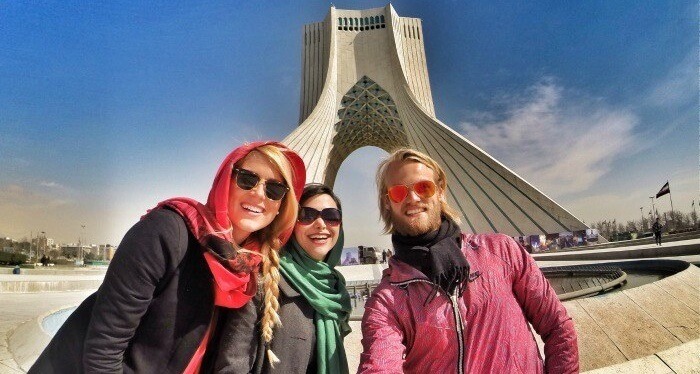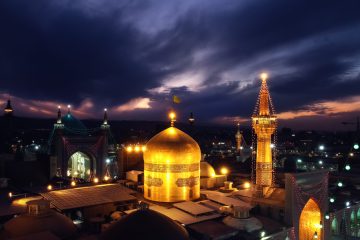
Can Americans travel to Iran?
Can Americans travel to Iran?
For Americans travel to Iran, While the U.S. Department of State advises against travel to Iran, we at Tours of Iran want to reassure you that we are committed to ensuring your safety during your trip to Iran.
In our increasingly interconnected world, more Americans are venturing abroad to explore new cultures and destinations. Iran, renowned for its rich history, breathtaking landscapes, and warm hospitality, is catching the eye of adventurous American travelers. But, before you set off on this journey, it’s natural to wonder if visiting Iran as a US citizen is feasible.
Despite the complex political history between the US and Iran, it’s crucial to separate politics from personal travel experiences. In this article, we’ll provide a clear overview of the possibilities, visa requirements, safety considerations, cultural etiquette, and practical details for Americans interested in visiting Iran. Our goal is to equip you with the knowledge needed to make informed decisions about your travel plans. So, let’s dive in and uncover the truth behind the question many have asked: Can I Travel to Iran from the USA?
Iran: Location, Culture, and History
Situated in the Middle East, Iran boasts a rich history and culture. Its diverse landscape ranges from snow-capped Alborz mountains to mesmerizing deserts like Dasht-e Kavir and Dasht-e Lut. Iranian culture, deeply rooted in history, encompasses influences from the Persian Empire, the Islamic Golden Age, and a vibrant artistic heritage. Travelers to Iran can immerse themselves in its unique traditions, architecture, literature, and cuisine.
Unique Attractions and Experiences
Iran’s appeal as a travel destination comes from its many unique attractions. The country boasts numerous UNESCO World Heritage sites, including the ancient ruins of Persepolis, Isfahan’s stunning Imam Mosque, and Tehran’s mesmerizing Golestan Palace. Nature enthusiasts can explore the otherworldly Badab-e Surt terraces or unwind on the pristine shores of the Caspian Sea. Iran’s warm hospitality allows travelers to engage with locals and gain insights into their daily lives and traditions.
Political Climate and Travel Advisories
Before considering a trip to Iran, it’s vital to be aware of the current political climate. Recent complexities in US-Iran relations have led to travel advisories from the US Department of State. These advisories provide essential information on safety concerns and potential risks. It’s essential to consult these advisories before making any travel plans, as they can help you understand the challenges you may encounter.
Iran Tours & Visa Guide for Americans 2023: Simplified Steps
Considering a trip to Iran from the USA in 2023? Here’s a concise step-by-step guide to ensure your journey is as smooth as possible.
- Choose a Travel Agency for Your Iran Tour
The journey begins with selecting a reputable tour company. This decision is crucial as your chosen agency will facilitate the visa process for you, streamlining your travel preparations.
- Submit Necessary Visa Documents
Once you’ve settled on a travel agency, the next step is visa application:
A scanned copy of your passport.
An official photograph.
Your planned travel itinerary.
Filled out visa application form.
A professional resume.
Your travel agency will manage the complexities of the paperwork and submit it on your behalf. Generally, expect this step to take around 45 working days.
- Obtain Your Visa
After the paperwork is processed, your tour company will receive an “Authorization Code” from Iran’s Ministry of Foreign Affairs. This step usually takes about two months. Once the code is in hand, you have two options to get your visa:
Option 1: If you’re in Washington, DC:
Visit the “Iranian Interests Section” at the Pakistan Embassy.
Submit your passport for visa processing, which takes roughly four days.
Collect your passport with the visa from the same office.
Option 2: Outside of Washington, DC:
Mail your documents directly to the Iranian Interests Section for processing.
Following these simplified steps will set you on your way to exploring the beauty and culture of Iran in 2023. Safe travels!
Can Americans Travel to Iran Without a Tour?
US citizens are required to visit Iran as part of an organized tour or with a private guide. Independent travel without a tour is not permitted for Americans. This requirement aims to ensure the safety and security of foreign visitors, allowing the Iranian government to closely monitor and regulate tourists’ activities and movements. Therefore, if you’re a US citizen planning to visit Iran, you must make arrangements through an authorized tour operator or a travel agency specializing in Iranian tours.
Note: Always carry your American passport, visa, and other necessary travel documents with you while visiting Iran.
Is Iran Safe in 2023?
Safety concerns naturally arise when considering travel to Iran as an American. However, it’s crucial to separate misconceptions from reality. Despite the geopolitical backdrop, Iran typically offers a secure haven for explorers. Iranians are known for their hospitality and kindness, contributing to a welcoming and secure environment. To make informed decisions, rely on accurate, up-to-date information from reliable sources like travel advisories and embassy notifications.
Regardless of your destination, prioritize safety with these general precautions:
Stay informed by keeping up with travel advisories and authorities’ guidance.
Familiarize yourself with local laws, cultural norms, and customs to avoid unintentional offenses.
Exercise caution with your belongings, especially in crowded areas or tourist sites. Opt for a money belt or secure bag to outsmart pickpockets.
Keep essential contact numbers, including those of your embassy or consulate, readily available. Keep the communication lines humming with loved ones in your homeland.
Remain vigilant in public spaces, particularly in crowded areas or public transportation. Rely on your inner wisdom and maintain a vigilant grasp of your environment.
Opt for reliable and licensed transportation services. Exercise prudence when utilizing public transit, and steer clear of solo nighttime journeys in unfamiliar locales.
While Iran is generally considered safe, be aware of specific regions or areas that may require extra caution, particularly those near borders with Afghanistan, Iraq, and Pakistan. Check the latest travel advisories and consult local authorities to assess the situation in specific regions before planning your itinerary. Staying informed and cautious in these areas will help mitigate potential risks.
Cultural Etiquette and Customs
Iran boasts a rich cultural heritage with distinct norms and customs. Understanding and respecting these cultural aspects enhances your travel experience. Iranians are generally warm and hospitable, deeply proud of their culture. Key aspects include strong family values, respect for elders, and a focus on hospitality. Traditional arts, poetry, music, and cuisine play significant roles in Iranian society.
When visiting Iran, keep these guidelines in mind:
Dress modestly, adhering to the Islamic country’s clothing modesty standards. Women should wear loose-fitting, non-revealing clothing covering arms, legs, and hair. Men should dress modestly, avoiding shorts and sleeveless shirts.
Avoid public displays of affection like hugging or kissing, as they are considered inappropriate.
Embrace polite gestures, like greeting with a handshake, offering compliments, and showing interest in Iranian culture and traditions.
Mind interactions between genders in public spaces, avoiding physical contact and maintaining a respectful distance.
Respectfully ask for approval before capturing moments of people or sacred sites through your lens. Respect any photography restrictions.
Major Tourist Destinations in Iran
Iran offers a diverse range of tourist attractions catering to various interests. Some highlights include:
Tehran: Iran’s capital blends modernity with tradition. Visit the Golestan Palace, the National Museum of Iran, and the bustling Grand Bazaar to experience its rich history and vibrant culture.
Isfahan: Known for its stunning architecture, Isfahan boasts iconic landmarks like the Imam Mosque, Sheikh Lotfollah Mosque, and the grand Naqsh-e Jahan Square. Explore picturesque bridges and lively bazaars.
Discover Shiraz, a city of poetry and gardens, where you can explore the stunning Nasir al-Mulk Mosque, marvel at the ancient Persepolis ruins, and find serenity in the Eram Garden.
In Yazd, step into the enchanting desert city with its winding old town, windcatchers, and mud-brick structures. Visit the Jameh Mosque, explore the Zoroastrian Fire Temple, and uncover the ingenious Qanats water system.
Persepolis: Near Shiraz, the ancient city of Persepolis is a UNESCO World Heritage site and a testament to the grandeur of the Persian Empire.
While most tourist sites in Iran welcome visitors, it’s essential to consider specific requirements or restrictions for certain destinations. Some historical sites may have restricted areas or require guides. Checking the latest guidelines and regulations before visiting is advisable, especially during peak seasons like Nowruz (Persian New Year).
Practical Information for Americans Travel to Iran
When navigating Iran, various transportation options are available. Domestic flights efficiently cover long distances, particularly between major cities with well-connected airports. Public transportation, such as buses and trains, provides budget-friendly travel between cities and regions. However, note that English-speaking travelers may find it challenging to navigate the public transportation system, so consider learning basic Persian phrases or traveling with a guide.
Additional tips for Americans traveling to Iran:
Handling money: Iran’s currency is the Iranian Rial (IRR). While international credit and debit cards aren’t widely accepted, ATMs in major cities allow cash withdrawals. Carry enough cash for smaller establishments and remote areas.
Communication: Wi-Fi is prevalent in hotels, cafes, and public spaces. Use translation apps or pocket-sized English-Persian phrasebooks for basic communication with locals.
Dress code: Adhere to the modest dress code. Women should cover arms, legs, and hair, and men should dress modestly. Scarves or head coverings for women are necessary in public areas.
Time zone: Iran operates on Iran Standard Time (IRST), which is UTC+3:30. Set your watches to the local time and plan your activities accordingly.
Health and safety: Consult your healthcare provider for necessary vaccinations or health precautions. Have comprehensive travel insurance to cover unforeseen medical expenses or emergencies.
Electrical considerations: Iran uses 220V electrical systems with Type C and Type F sockets. Carry plug adapters and voltage converters if they are necessary.
Final Takeaway
We encourage you to consider visiting Iran and experiencing its rich culture and history firsthand. Iran’s hospitality, architectural wonders, and historical legacy offer a captivating journey. Approach your trip with an open mind, respect for local customs, and a willingness to engage with Iranians to create lasting memories and gain a deeper understanding of this remarkable nation. So, if you’re an American traveler seeking a unique adventure, consider adding Iran to your travel bucket list.








